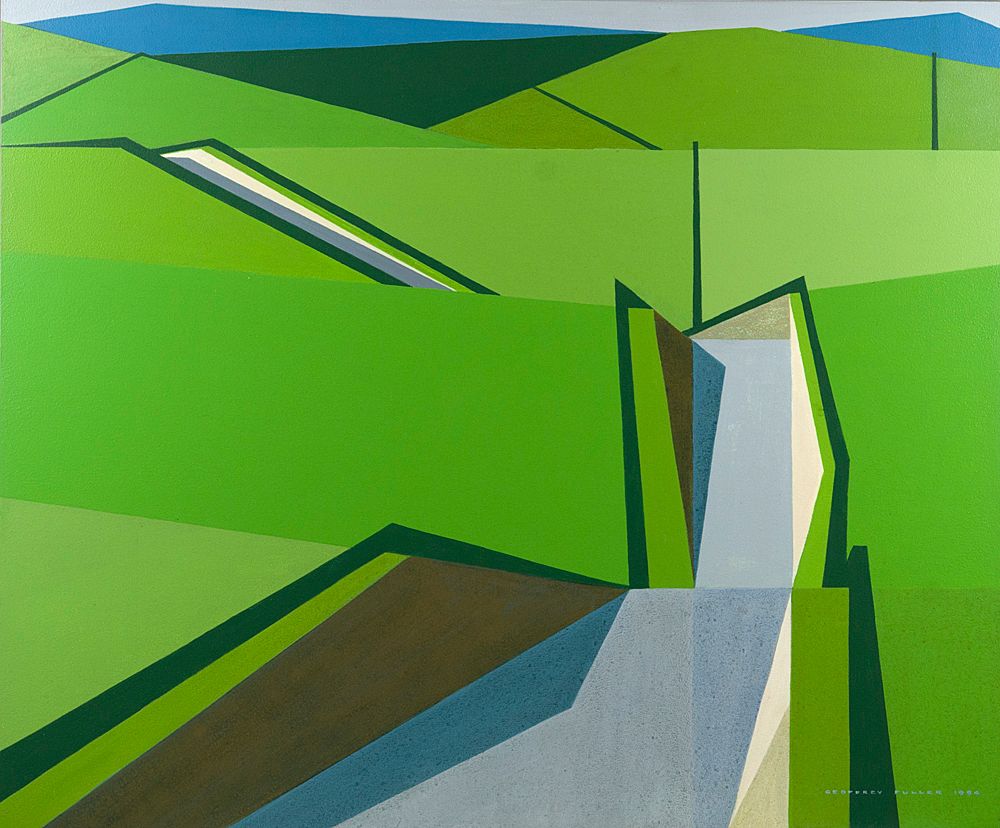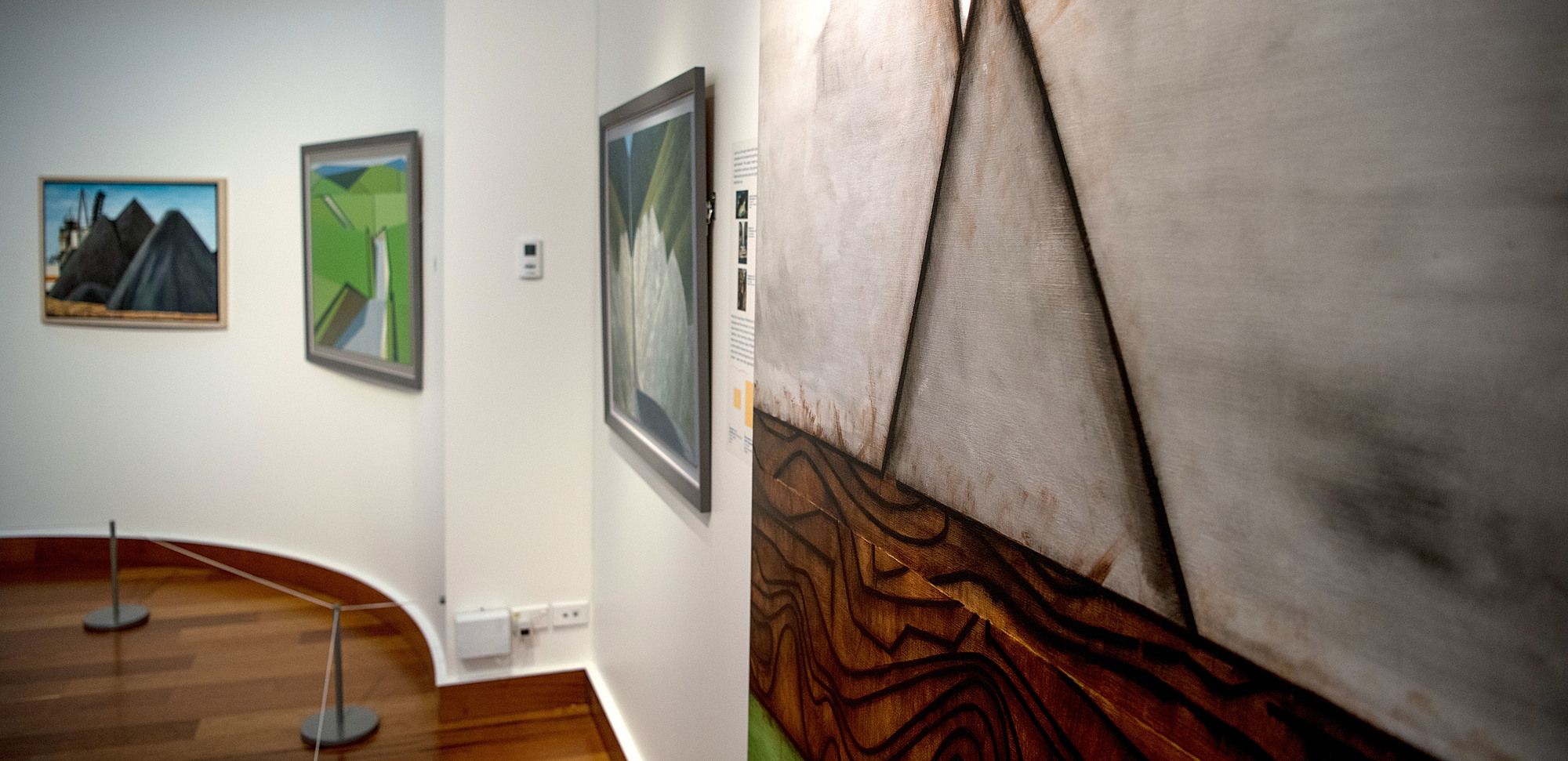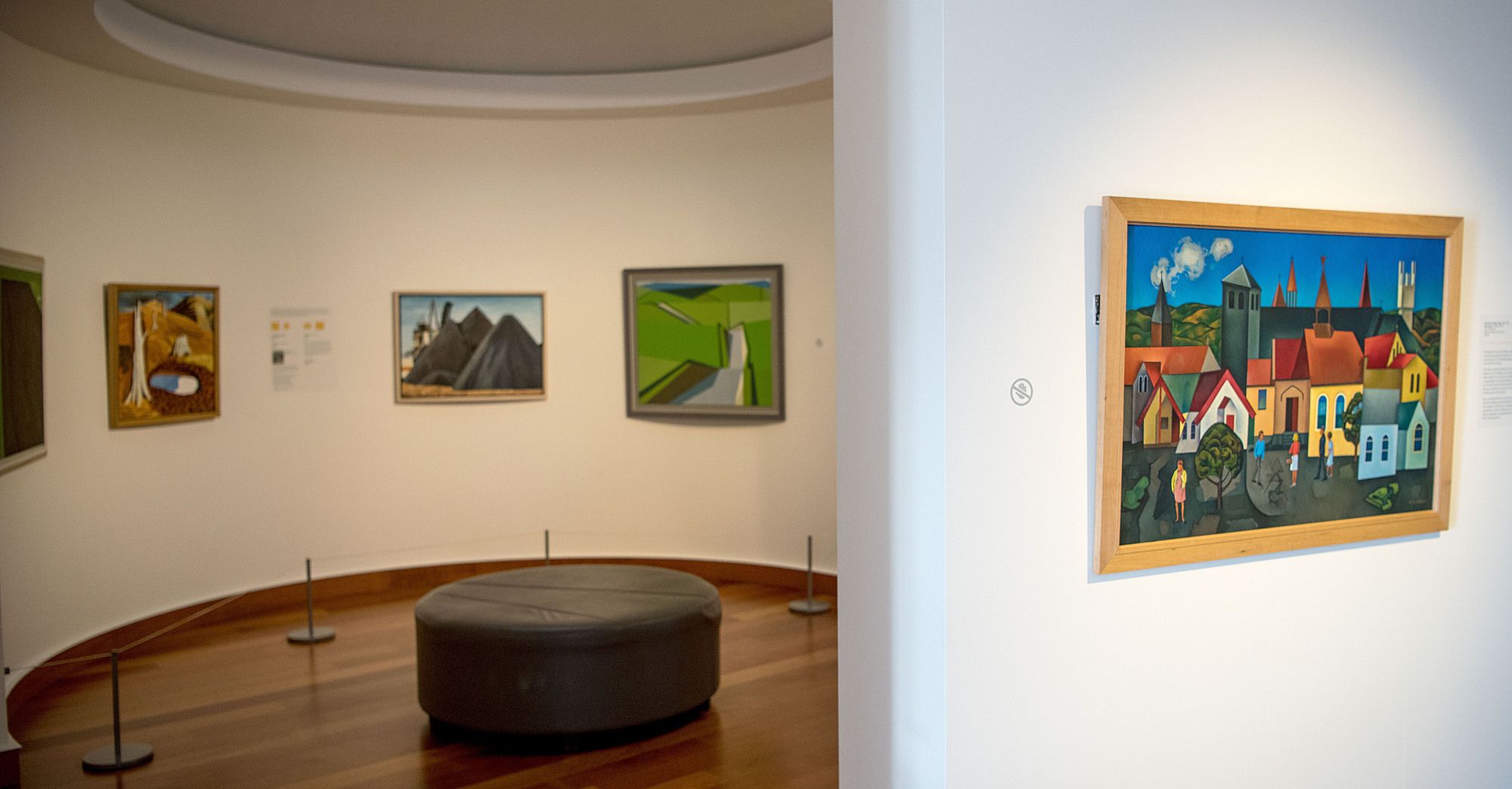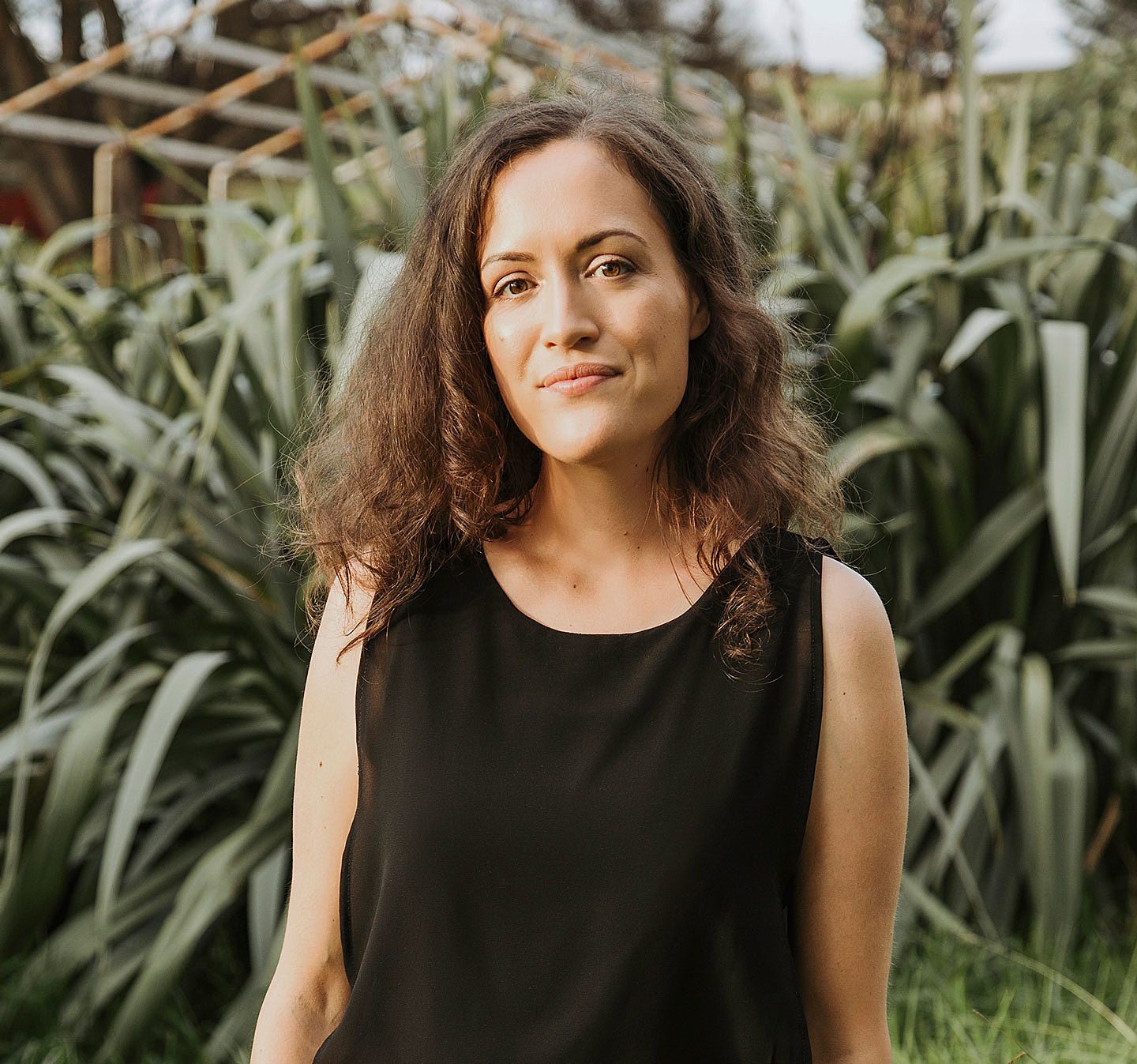Beyond the Mamae: A Review of Five Pākehā Painters
Not just People of Colour have an identity. Jade Kake looks at how White settler identity is framed in her review of Five Pākehā Painters: Perspectives on Hawke’s Bay.
Not just People of Colour have an identity. Jade Kake looks at how White settler identity is framed in her review of Five Pākehā Painters: Perspectives on Hawke’s Bay.
Five Pākehā Painters: Perspectives on Hawke’s Bay is a new exhibition, presented at MTG Hawke’s Bay and curated by Jess Mio (Pākehā), which features works by Rita Angus, Jenny Campbell, Geoffrey Fuller, Dick Frizzell and Martin Poppelwell. The exhibit examines several key aspects of Pākehā visual and material culture, identifying underlying cultural values and assumptions, and the stylistic choices made within this cultural context. The 12 artworks, painted between 1925 and 2016, have been presented in a radically new way – not by era, style, medium or oeuvre, but in terms of relationships to land, as viewed through a Pākehā cultural lens but understood in relationship to Māori conceptions of whenua and te ao taiao. An inherent tension within Pākehā attitudes towards landscape is identified at the outset – between appreciation on one hand, and entitlement to resource extraction and modification on the other.
The paintings are complemented by poetry, small reproductions of works held elsewhere, and critical commentary. The title deliberately references the Five Māori Painters exhibition curated by Ngahiraka Mason (Ngai Tūhoe, Te Arawa, Ngāti Pango) presented at the Auckland Art Gallery Toi o Tāmaki in 2014 and featuring works by Robyn Kahukiwa (Ngāti Porou, Te Aitanga-a-Hauiti, Ngāti Hau, Ngāti Konohi and Te Whānau-a-Ruataupare), Kura Te Waru Rewiri (Ngāpuhi, Ngati Kahu, Ngāti Rangi, Ngati Raukawa ki Kauwhata), Emily Karaka (Ngai Tai ki Tāmaki, Ngāti Hine, Ngāpuhi), Star Gossage (Ngāti Wai, Ngāti Ruanui) and Saffronn Te Ratana (Ngai Tūhoe), presenting the understanding that Pākehā identity can only be positioned as relative to Māori. The show also builds on the precedent set by the ground-breaking Pākehā Now! exhibition, curated by Anna-Marie White (Te Ātiawa) and presented at The Suter Art Gallery in Wakatū Nelson in 2007.
The first theme explored is the concept of dominion and private property ownership, and the myriad of ways in which Britain’s political and economic system was transplanted or imposed within a new land. Geoffrey Fuller’s Pastorale (1971) shows a patchwork of rectangular parcels located between the intersecting curves and waves of the mountains and the sea, illustrating a fundamental tension between Māori and Pākehā worldviews.
The second theme explored is the concept of exploitation, and the landscape as a site of resource extraction. Two paintings by Dick Frizzell – Napier-Taupō Road Landscape (1986) and Shingle Works, Hawke’s Bay (1987) lay bare the process of mining and deforestation, illustrating the dramatic changes to the landscape made by Pākehā society since colonisation. The ‘opportunity cost’ for development activities – in the case of Shingle Works, Hawke’s Bay (1987), the mining of the Awatoto site to extract materials for the Napier rebuild following the 1931 earthquake – are felt and remembered by tāngata whenua in a way that is rarely acknowledged by Pākehā.
The third and final theme explored is the stylistic choices of Pākehā painters. It draws attention to the composition, framing and materials drawn from the Western tradition. A comparison between the two works, Summer Landscape, Hawke’s Bay (1946) by Rita Angus (who was educated in New Zealand), and Tukituki River (1925) by Jenny Campbell (who was educated in Edinburgh), demonstrates the stylistic similarity between the two artists. Despite receiving their artistic training in vastly different geographic contexts (the colony and the motherland), their styles appear culturally homogenous with limited integration and adoption of Māori visual styles.
The exhibition exemplifies critical curatorial practice, positioning Pākehā as a political and actively decolonial identity
The exhibition exemplifies critical curatorial practice, positioning Pākehā as a political and actively decolonial identity. Significantly, curator Mio explicitly identifies as Pākehā, providing a pepeha for themselves and a working definition of Pākehā. There is strength in this positioning – for Mio and other Pākehā – and an implicit understanding that Pākehā identity and culture can only exist in relation to Māori identity and culture, in the particular condition of settler-colonialism in unceded territories and structured by the unique relationship formed through Te Tiriti o Waitangi.
Māori and Indigenous curators – such as Ngahiraka Mason, Stephen Gilchrist (Yamatji), Genevieve Grieves (Worimi), Léuli Eshrāghi (Sāmoan, Persian), Chandra Frank (Dutch, South African) and others – have been critical in pointing out (and dismantling) the racist and colonial foundations of mainstream curatorial practice. As theorised by Terry Goldie (settler Canadian), a key feature of settler colonialism is for settler cultures to undergo a process of ‘indigenisation,’ assuming a new identity rooted in the land, as the transplanted culture destroys, obscures, or assimilates the indigenous. This erasure is essential to the colonial project, creating one unified homogenous culture, subsuming one beneath the other to permanently extinguish claims to self-determination and self-governance.
For this reason, the framing by Mio is astounding. The thing about colonial culture is that it positions itself as normative, with all other cultures perceived as the ‘other.’ As tangata Māori – albeit not one with whakapapa links to the Hawke’s Bay – it meant a great deal to me to see Pākehā identity and relationship to the whenua framed in this way. Not as the assumed default, the insidious way colonialism reinforces itself as it erases what was there before. Through Mio’s careful curation, a light has been shone on Pākehā as a unique culture and identity, rooted in this land and inextricably linked to colonialism. There is strength in this position. This positioning does, however, raise a number of questions – would another curator have been able to be as bold or explicit as Mio has been? Could the exhibition have been done by a Māori curator? How would it have been received?
My impression is that Māori are not the intended audience for this exhibition, or at least not primarily. The focus, in my view, is really on Pākehā educating Pākehā, similar to the work done by Network Waitangi in the 1980s and 90s where Pākehā (mostly women) educated other Pākehā on the importance, significance and meaning of the Treaty. Building on the numerous advances made possible by increasing recognition of Te Tiriti, Pākehā are now in the privileged position of being able to embrace te ao Māori and te reo Māori without necessarily having to confront the intergenerational trauma associated with colonialisation and cultural genocide. Critically engaging with the idea of a Pākehā identity and culture requires Pākehā acknowledging the mamae associated with our colonial past and present. For Māori, this may mean confronting the internalised harmful racist ideas that we often carry, and the shame that many of us experience for not knowing our reo, our whakapapa, our tīkanga. These can be difficult conversations to have.
imagine a future where their Pākehā identity can be positively defined – relative to Māori – and embraced
For these reasons, the show may be controversial, and even confronting to some. Although MTG Hawke’s Bay has consistently maintained an excellent taonga Māori collection, and regularly exhibits contemporary art by Māori artists, Napier itself is a town with an ageing, majority Pākehā population and identity. Given the city’s demographics, I wonder how Napier residents have received the show. Is the likely response defensiveness, or self-reflection and acceptance? One possible critique of the show is that in being so focused on reframing the past, it fails to offer any alternatives to hegemonic Pākehā culture, and therefore doesn’t provide opportunities for Pākehā to imagine a future where their Pākehā identity can be positively defined – relative to Māori – and embraced.
This exhibition, although small, is significant. Art has the power to question, to shift our cultural norms. Art can shift power and transform our political and economic systems. What happens here matters in shifting the discourse within wider society. By explicitly naming and describing Pākehā culture, the show is unashamedly political, actively decolonial, transformative and self-reflective. This is the kind of critical curatorial practice we need, if we’re committed to Te Tiriti and serious about our relationship as tāngata whenua and tāngata tiriti.



